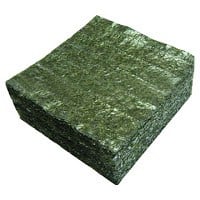Nori (Dried Seaweed Wrap)
What is nori (seaweed wrap)?

It can also be added to soups and seafood dishes to add its salty and savory flavor, for example. If you do wish to use nori in soups, be careful as the seaweed is dried and thus will expand enormously when re-hydrated. It will even absorb water from the air when stored, and therefore should be stored tightly in a container with a desiccant pack (those little white packs that absorb moisture in the air) if not used soon after purchasing and opening the package.
Nutritionally, nori is high in protein, minerals, vitamins and fiber. One sheet, which can be used for an entire roll of sushi, will add only 13 calories to the roll. This is a boon for some people as it is practically an essential ingredient in sushi as we know it today. About a third of this food is protein and a third fiber, making it one of the main reasons sushi is an excellent meal choice. While nori is rarely enjoyed alone in the Western world (though the popularity of toasted nori snacks is increasing in the West), the nutritional benefits can be gained by simply toasting it with sesame oil or soy sauce and enjoying it as a stand alone snack.
The Nori Market And How It Is Made
Nori is harvested in a complex but well understood aquatic agricultural practice. The seaweed is farmed in the sea where it grows on large nets suspended on the surface of the sea. These plants grow at a rapid pace, taking only 45 days to be ready for their first commercial harvesting from the time of seeding. In Japan, which is the largest producer of nori, over 230 square miles of coastal waters are used to produce a staggering 350,000 tonnes of it yearly for the global market.
The nori market is a huge business which fortunately has ensured that the process is efficient. Nori is actually a red seaweed as it grows, falling under red algae family of porphyra. However, the processing nori, which includes shredding, drying, and roasting, changes the color to the dark green that we know. Once processed, it will become even darker as it ages.
If you eat sushi, you cannot remain unfamiliar with nori due to its ubiquity. While many newcomers to sushi are worried about the concept of eating raw fish and may stick to vegetarian rolls, they may be blissfully unaware of the fact that this nutritious and and useful seaweed is right under their nose!
I have always been fascinated by the creation and culture of different foods, particularly sushi and sashimi in the modern era of Japanese cuisine. I am a classically trained chef and sushi connoisseur, also having operated a food service company and enjoy investigating and experimenting with food around the world.